Mon, 15 Sep 2014 . Last updated Thu, 25 Jun 2015 08:49

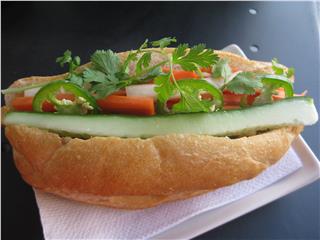
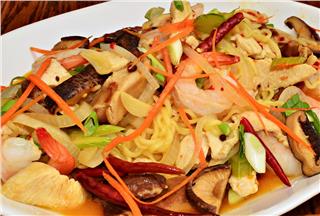

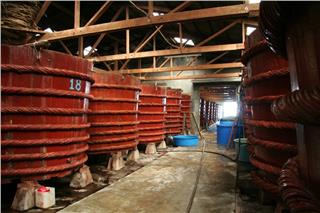

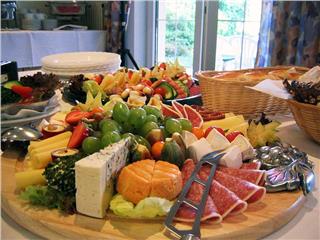

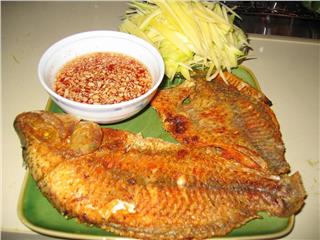
Now I am in Tra Vinh province. Today, we are going to learn more about Tra Vinh cuisine how it is different from other regions of Mekong Delta. Firstly, I will go north to Cau Ke district to check out “dua sap”, a type of coconut unique to the area. Then I will travel back near the main town to learn how to make “banh trang”, a well-known rustic rice paper in Luong Hoa district. Next it is worth to enjoy a different flavor of “banh tet” in Cau Ngang district. Then I go south to Duyen Hai district to try some local sea and mangrove forest delicacies.
Khmer people in Tra Vinh account up to 25% of the Khmer population in Vietnam. As the result, Khmer culture has become the Tra Vinh identity. Khmer temples are very well-known in the South of Vietnam. Some of them recognized as national historic sites. Although many were renovated recently, you can still easily recognize these temples by their distinctive arched dome and the yellow color very eye-catching.
Most Khmer boys were spent time in Khmer temples at one point in their lives. Inside the purest, they learn Khmer language and Buddha philosophy. I also learn something about Buddhism visiting this place. I have read some documentaries which say a long time ago, a Khmer monk brought a seed from Cambodia to Vietnam. Whatever the reason may be due to genetic variation, adaptation to the new weather conditions and new land, this seed has now become a local specialty, a unique fruit of Tra Vinh province.
I followed the Khmer kids to a village in Cau Ke district, the place which is said to have most “dua sap” or literally wax coconut tree in Tra Vinh. This is special fruit that I was talking about, in Vietnamese it is called “dua sap” which is translated literally into wax coconut. It is known widely in the world as the name Macapuno. A wax coconut looks no difference from other kinds of coconut that until its shell is removed, inside it is an aromatic and pulp is thick and soft that resembles a type of wax pudding. The more it ripens, the softer the pulp gets. And the ticker the pulp gets too. And the juice becomes sweeter. It is not as sweet as normal coconut but it is more buttery. Because of the thickness and the wax water inside the coconut, the fruit is called wax coconut.
The weather in Tra Vinh is just incredibly hot, and that’s why the dishes like rice paper rolls is one of the favorite dishes of people in this area. Vietnamese wrapping rolls are made from fresh ingredients having taste from the sea and may other ingredients available in the delta.
Tra Cuon village in Nha Truong district is known for “banh tet”. “Banh tet” is enjoyed during the Tet holiday and “banh tet” made here all year round is not different from normal “banh tet”. Rice quality and seasoning are the key to make a delicious “banh tet” in Tra Cuon village, Cau Ngang district. Local people use a special type of glutinous rice that is called “nep sap”. It’s more chewy and fragrant. “Banh tet” here is enjoyed with caramelized pork, dried shrimps and pickled onions. “Banh tet” or tet cake is very popular dish all over Vietnam, but each region has its own way of making the cake. In Tra Vinh, people have a taste for very strong flavor so “banh tet” here are also made ingredients which have very strong flavor. Not only do these tastes good they are also a masterpiece of art. For Khmer people, banh tet is often enjoyed with just a mung bean and pork fat filling. The Kinh people like to have meats inside their cakes. And the Chinese ethnic group likes to have salted eggs. Banh tet here reflects the food preferences of all 3 ethnic groups here including the Kinh, Chinese and Khmer people. So this not only tastes good, but it’s a great cultural combination. For try two different dishes in Tra Vinh, there were banh trang and banh tet, these dishes are not unique dishes in the Mekong Delta region, you can find them anywhere in Vietnam, but what is unique about them is the taste. Here people like things with strong flavor and also reflect a part of the culture of their daily cuisine in Tra Vinh.
With 65 kilometers of coastline, Tra Vinh is one of the provinces blessed with delicious seafood. As I went to Tra Vinh southeast, I reached Duyen Hai coastal district, local people here are living by fishing and drying aquatic products. To enjoy the delicious taste of the sea, I went to Ba Dong beach to meet Tam, a local fisherman. Tam takes me buy ingredients and nowhere else but right on the sandy beach where local women are classifying their catch. The beach is the best place to get fresh and cheap seafood. What is the simplest way to enjoy fresh fish and vegetables? In the Mekong Delta, local people just put everything in a pot of water.
Long Khanh mangrove forest is about 60 kilometers out of Tra Vinh city. What I have heard that this area is famous for an animal looking like a crab. It is called “chu u” in the local language. According to Mr. Duan, brackish water crabs often shelter deep in the mod layer, around the tree root. Actually this animal eats tree root to grow. After experiencing a painstaking job, catching crabs in the mangrove forest, I have given permission by Duan to indulge myself at his house. What is more relaxing and listening to the beautiful melodies of Don Ca Tai Tu while waiting for the dish cooked. This is a very unique experience that you can only have in the Mekong Delta.
Source: VTV4 – VTV.vn

 Đặt vé máy bay cho người Việt?
Bấm vào đây
Đặt vé máy bay cho người Việt?
Bấm vào đây
Our service uses cookies for technical, analytical and marketing purposes. See our Cookie và Privacy policies for more information. If you agree to this, just keep browsing.


